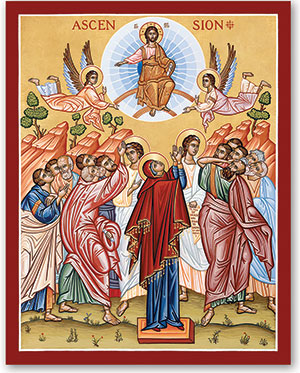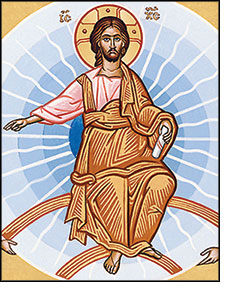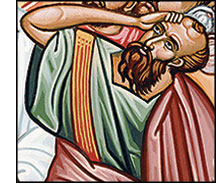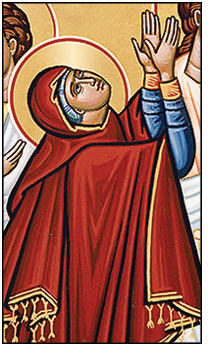 "Icons invite a quiet looking." —Linette Martin, author of Sacred Doorways
"Icons invite a quiet looking." —Linette Martin, author of Sacred Doorways
"What the Book of the Gospels explains by means of words, the iconographer shows by means of his works." —Saint Basil the Great
Icons have their own language, developed over the milennia. Since so many of the faithful of earlier times were illiterate, it was a vital means of conveying the deeper messages of the Gospel events. So, taking the advice of author Linette Martin, let's give a quiet looking to Monastery Icons' depiction of the Ascension (celebrated last week) and see what it is telling us.
The artist has shown us two themes: the transcendental nature of the ascending Christ in the top third of the icon, and the awe and consternation of the Apostles below.
 Sitting on a throne of light, holding a scroll of the Gopels with one hand and blessing with the other, the resurrected Savior ascends in a globe of light. This radiance appears to come from Christ Himself, in the exact same style that iconographers use when they show the transfigured Christ on the Mount of Tabor. And at the same time it is a symbolic representation of the door to heaven, through which Jesus is about to leave the limitations of earthly time and space. He ascends in stately glory, flanked by holy angels who appear to assist in this ascent.
Sitting on a throne of light, holding a scroll of the Gopels with one hand and blessing with the other, the resurrected Savior ascends in a globe of light. This radiance appears to come from Christ Himself, in the exact same style that iconographers use when they show the transfigured Christ on the Mount of Tabor. And at the same time it is a symbolic representation of the door to heaven, through which Jesus is about to leave the limitations of earthly time and space. He ascends in stately glory, flanked by holy angels who appear to assist in this ascent.
The scene below is quite different! As the Gradual for the Ascension Mass says, "God has gone up with a shout" – and in this case the shout seems to come from the Apostles, who are surprised, amazed, and reaching out to Christ in longing. By contrast two angels stand calmly in their midst, one of them holding a scroll with their words as quoted in the Book of Acts: "Ye men of Galilee, why do you stand gazing up into heaven?"
 Among the Apostles, in the lower right we see the figure of Saint Paul, who of course was not historically present. But iconography frequently transcends time, so the iconographer has shown Saint Paul as "present in spirit."
Among the Apostles, in the lower right we see the figure of Saint Paul, who of course was not historically present. But iconography frequently transcends time, so the iconographer has shown Saint Paul as "present in spirit."
In the midst of the band of astounded Apostles stands the quiet figure of the Holy Virgin, standing tall and still.  No stranger to miraculous events, she is focussed on her ascending Son as He departs this world, raising her hands in both honor and longing. To emphasize her elevated status among all mankind, the iconographer places her on a small platform. The royal red of her robes dominate the center of the image, emphasizing her central and spiritually regal role in the path to salvation.
No stranger to miraculous events, she is focussed on her ascending Son as He departs this world, raising her hands in both honor and longing. To emphasize her elevated status among all mankind, the iconographer places her on a small platform. The royal red of her robes dominate the center of the image, emphasizing her central and spiritually regal role in the path to salvation.
This scene clearly demonstrates the dynamism of iconography, and its ability to bring into immediacy what is too often for many of us a flat image in sacred history. And the great "lesson" of the icon is not in words, but in what the artist seeks to evoke in us: both a sense of the glory of the resurrected Christ, and the need for our hearts and minds to ascend with Him.